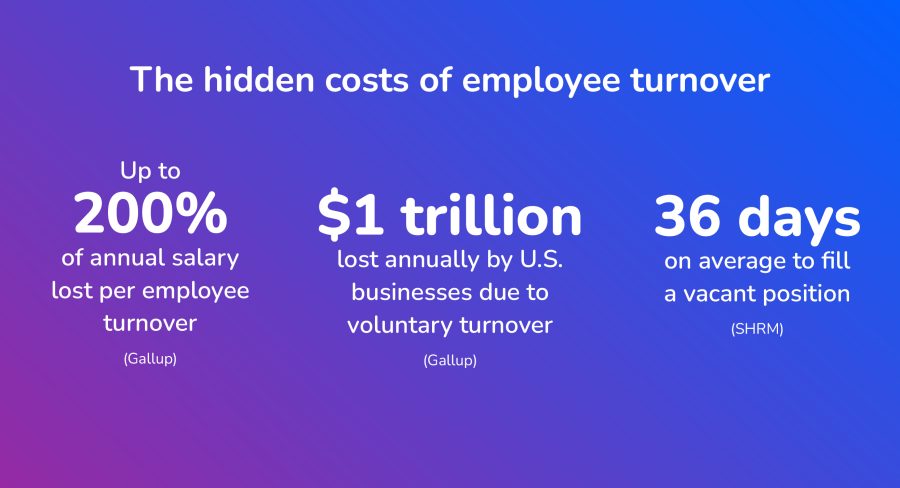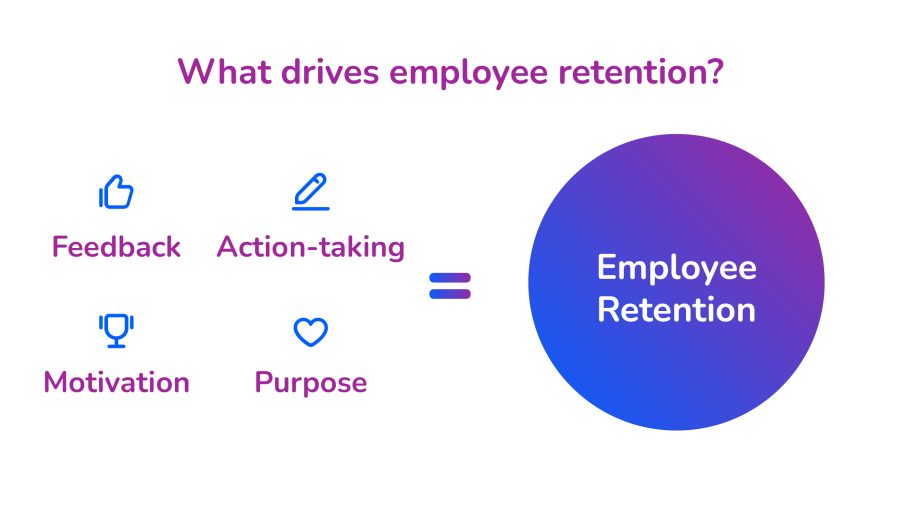Understand the real cost of employee turnover and how gamification can help reduce it.

Back to Blog
High employee turnover isn’t just a revolving door of faces, it’s a significant drain on a company’s resources, productivity and team morale. And if you think that employee turnover might not be a problem in your organization, think again.
It’s no secret: a sense of disconnection is running high in today’s workplaces. In fact, 77% of employees, globally, say they feel disconnected from their company. And it’s showing – Gallup reports that over half of U.S. employees are either watching for or actively looking for a new job.
That’s not just (the costs of) turnover: that’s a mass talent loss in progress. But here’s the upside: 42% of that turnover is preventable. The key lies in rethinking how we engage team members, creating workplaces where people feel seen, valued and connected to a greater purpose. And you can start making that shift today.
Engagement might be your best defense against employee turnover. Not the fluffy “free snacks and a ping pong table” kind of engagement – real, meaningful, “I want to stay and grow here” engagement.
Let’s dive into the real costs of employee turnover and the engagement strategies companies should be using right now to reduce the impact of losing employees, while keeping their workforce motivated and ready to find purpose in committing to the organization.

Imagine pouring resources into training employees, only to see them walk out the door shortly after. The financial impact is more than just a headache; replacement costs are a substantial hit to your bottom line. Studies reveal that replacing someone can cost anywhere from 30% to 200% of an employee’s annual salary, depending on the role and industry.
Let’s break these investments down so you can have a clear view of the cost of a departing employee:
Hiring costs: Expenses related to job postings, recruiter fees, and interview processes.
Onboarding costs: Training programs, orientation sessions, and initial productivity losses.
Development costs: Continuous training and professional development investments.
Unfilled time: The gap between an employee’s departure and their replacement’s start date, leading to lost productivity.
Seems like a lot, right? Well, it is. But worry not, the right engagement strategies can help you reduce some of these costs, while retaining your top talent.
1. Help people connect to a bigger purpose
Employees don’t stay only for a paycheck, they stay for meaning. When people see how their work contributes to something larger, they become more invested, more fulfilled and more likely to stick around.
According to McKinsey, employees who find purpose at work are more likely to stay long-term. It’s not just about having a mission statement on the wall. It’s about weaving that purpose into everyday conversations, decisions and goals.

Make it a habit to explain the “why” behind projects, connect individual roles to company impact and celebrate the progress toward shared goals.
When kicking off a new project, take a moment to share the broader context: why it matters, who it benefits and how it ties back to the company’s mission.
During one-on-ones or team meetings, highlight how each person’s contributions are making a difference, not just in metrics, but in real-world outcomes.
Recognize and celebrate milestones that reflect collective progress. Over time, these moments of connection build a deeper sense of meaning, turning routine work into something people genuinely care about.
2. Prioritize career development (because no one wants to feel stuck)
One of the fastest ways to lose a great employee? Let them stagnate.
LinkedIn found that 94% of employees would stay longer at a company that invests in their career development. People want to learn. They want to grow. And they want to know that their employer has a plan for them beyond just this quarter.
That doesn’t always mean expensive training programs. Create space for mentoring, offer stretch assignment or bring in guest speakers. Even better: gamify development goals, so skill-building feels less like a chore and more like progress you can actually see. Instead of vague targets like “improve leadership skills” or “be more proactive,” break goals into clear, trackable milestones.
For example, completing a set of training modules could unlock a digital badge. Mentoring a colleague might earn points toward a learning leaderboard. Or reaching a certification could level someone up in a visible skills framework.
Add friendly competition by setting up team challenges around learning topics, or create progress dashboards that turn growth into something visual and rewarding. When people can see their progress, and get recognized for it, they’re far more likely to stay engaged and motivated.
3. Build a company culture that supports balance and belonging
Burnout is real. And it’s one of the leading causes of voluntary turnover. Gallup reports that 76% of employees experience burnout frequently — and those who do are more than twice as likely to be actively looking for a new job.
You can’t talk about engagement without talking about well-being. Employees can’t do their best work if they’re feeling like just another cog in the machine. Real engagement starts with care – encouraging people to take time off (and truly disconnecting when they do), being mindful of workloads and building a culture that respects boundaries.
It also means creating space for people to show up as more than just their job titles, to connect as humans, with all the creativity, empathy and individuality that brings.
Even small, intentional efforts can make a big impact. Think virtual coffee chats where teams catch up without an agenda, monthly wellness challenges that get people moving and laughing, or team-led workshops where colleagues share passions outside of work.
A little friendly competition through gamified team activities can also breathe new energy into remote or hybrid setups. These moments of connection may seem simple, but they can help transform the workday into a more humane and engaging daily experience.
4. Make feedback a two-way street
You can’t fix what you don’t know is broken. So, why not ask? Feedback isn’t just a nice-to-have: it’s a powerful retention tool. In fact, 90% of employees say they’re more likely to stay at companies that actually act on their feedback.
But here’s the catch: collecting feedback isn’t enough. A quick pulse survey won’t move the needle unless you follow through. That means sharing what you heard, communicating what actions are being taken, and keeping the team in the know as things progress.
To truly build a culture of listening, feedback needs to be part of the everyday rhythm. Don’t limit input to formal surveys: offer multiple ways for people to speak up.
Anonymous channels can help surface concerns that might not come out in meetings, while real-time feedback tools open up honest, in-the-moment insights.
When employees see that their voice matters and that it leads to real change, they become more engaged, more loyal and more likely to grow with the company.
5. Take advantage of gamification to make work more motivating
Gamification isn’t just a buzzword. It’s a proven engagement strategy backed by behavioral science. At its core, gamification uses elements like points, leaderboards, challenges and rewards to tap into what naturally motivates people: recognition, achievement, competition and progress.
When done well, it doesn’t trivialize work. It makes it feel more rewarding. That’s where vaibe comes in.
vaibe is more than just a gamification solution. It’s an employee engagement solution designed to drive enjoyment, productivity and efficiency, giving every employee the opportunity to stand out.
caibe uses game elements like challenges, leaderboards and rewards to strengthen company culture, boost morale and motivation and ultimately reduce turnover while increasing productivity.
Turn employee engagement into your competitive edge. Discover how vaibe helps businesses cut turnover costs and boost performance through smart gamification. Get started today.
Struggling with disengaged teams, inefficiencies or high turnover?
Discover how gamification transforms challenges into wins!
Discover how gamification can significantly reduce turnover rates in contact centers by boosting motivation and productivity.
Learn how game mechanics, rewards and motivation strategies influence employee engagement.